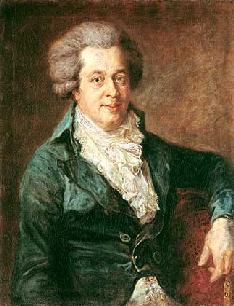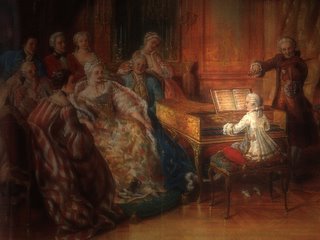Friday, January 27, 2006
Mozart: Exultate, ,jubilate, K.165
(Left) A newly discovered painting of Mozart in Munich 1790 by Johann Georg Edlinger

(Right) The little Mozart at the keyboard is adorable, complete with tiny shoes kicked off and lying under the harpsichord -- and the look of love and pride on Leopold's face is priceless.
The little Mozart at the keyboard is adorable, complete with tiny shoes kicked off and lying under the harpsichord -- and the look of love and pride on Leopold's face is priceless.
Today is the day to celebrate the birth date of our dear composer. 250 years young (could Mozart ever be old?) There are few composers in the history of Western music who bequeathed such a valuable and at the same time varied body of vocal music as did Wolfgang Amadeus Mozart.
The virtuoso motet Exultate, jubilate K.165, is structured like a concerto with three movements, yet in this case it is a soprano that engages in a dialogue with the orchestra, not a solo instrument. I feel the text is quite appropriate to our birthday boy.
1.
"Rejoice, shout
o you blessed souls,
singing sweet hymns;
responding to your song
the skies sing psalms with me."
2.
"The friendly daylight shines,
both clouds and storms have now fled;
for the righteous an unexpected calm has come.
Everywhere dark night reigned,
rise up at last in gladness,
you who were afraid until now,
and joyful present to the happy dawn handfuls of lilies.
You crown of virgins,
give us peace,
you, ready to give comfort
wherever a heart sighs."
3.
"Alleluia."
Indeed, the last movement comprises a jubilant set of "Alleluias."
I recommend the recording by Judith Blegen with the Mostly Mozart Festival Orchestra, Essential Classics/Sony SBK 62646.
Cheers,

(Right)
 The little Mozart at the keyboard is adorable, complete with tiny shoes kicked off and lying under the harpsichord -- and the look of love and pride on Leopold's face is priceless.
The little Mozart at the keyboard is adorable, complete with tiny shoes kicked off and lying under the harpsichord -- and the look of love and pride on Leopold's face is priceless.Today is the day to celebrate the birth date of our dear composer. 250 years young (could Mozart ever be old?) There are few composers in the history of Western music who bequeathed such a valuable and at the same time varied body of vocal music as did Wolfgang Amadeus Mozart.
The virtuoso motet Exultate, jubilate K.165, is structured like a concerto with three movements, yet in this case it is a soprano that engages in a dialogue with the orchestra, not a solo instrument. I feel the text is quite appropriate to our birthday boy.
1.
"Rejoice, shout
o you blessed souls,
singing sweet hymns;
responding to your song
the skies sing psalms with me."
2.
"The friendly daylight shines,
both clouds and storms have now fled;
for the righteous an unexpected calm has come.
Everywhere dark night reigned,
rise up at last in gladness,
you who were afraid until now,
and joyful present to the happy dawn handfuls of lilies.
You crown of virgins,
give us peace,
you, ready to give comfort
wherever a heart sighs."
3.
"Alleluia."
Indeed, the last movement comprises a jubilant set of "Alleluias."
I recommend the recording by Judith Blegen with the Mostly Mozart Festival Orchestra, Essential Classics/Sony SBK 62646.
Cheers,
Thursday, January 26, 2006
Carl Philipp Emanuel Bach
Carl Philipp Emanuel Bach, the third son (second surviving one) of Johann Sebastian Bach, was born (1714) in Weimar, and died (1788) in Hamburg. Having made the latter town his principal residence, he is known as the Hamburg Bach---a mark of identification which serves to distinguish conveniently one particular member of so very numerous and individually famous a family. The family decreed that Philipp should study law, but his inherited passion for music prevailed, and under his father's training he soon became proficient and ultimately almost as famous in his particular way as his immeasurably greater progenitor. He was a brilliant harpsichord player, and it was the elegance and refinement of his taste, rather than depth and power of real genius, that made him more accessible to the public and won him far greater popularity and admiration---for a time---than were commonly bestowed upon his father. His famous book, Experiments in the True Art of Clavier Playing (1759), betrays the trend of his musical preferences. But he was a prolific composer, and his music (chiefly instrumental), though more graceful and ingratiating than profound character, was sufficiently original and significant to serve as an inspiration and model for succeeding generations. His music exerted an immense influence on Haydn, whose early Symphonies are conceived in the selfsame spirit and manner.
Philipp Emanuel Bach wrote eighteen Symphonies, the third of which, composed in 1776, is here outlined as a specimen of his orchestral style. It is scored for the quintet of strings, two flutes, two oboes, one bassoon, one horn, and cembalo(harpsichord). The first Movement has no Introduction and the form is rather obscure. There is no double-bar to mark the end of the Exposition, though the presentation of the usual two well-defined Themes seems to round out the first Division recognizably; a sort of Development, not quite genuine in its relation to the foregoing, leads over into the subordinate Theme, without a return to the beginning---thus corroborating the expanded Two-Part form. Several allusions to the principal motive, in various keys, are interspersed throughout, imparting to the whole a loose "sectional" impression. The Movement closes on the dominant of D minor, and passes without break over into the second Movement: this is a lyric Movement of very real melodic beauty. The melody is carried almost constantly by the viola. The concise design approximates the Two-Part Song-form, however, there is but one Theme.
There is a remarkable degree of similarity between this second Movement Theme with the Theme of the first Movement; like the first one, closes with the dominant chord of the following Presto, and is joined to it without pause.
The third, and final, Movement is a conventional lively Presto, inclining more toward the graceful than to the rollicking style. The subordinate Theme is extended by a Codetta, and the close of the Exposition is emphatic. But, as in the first Movement, there is no complete Recapitulation; the Development merges into the recurrence of the subordinate Theme (transposed, as usual), and the design therefore does not exceed the expanded Two-Part form.
The similarity of thematic invention between the themes of this Symphony and many of those of Mozart, in both his youthful and more mature periods, is as unmistakable as it is striking and noteworthy. It is, however, more of an external coincidence than a conscious imitation; for though Mozart was familiar with the music of the younger Bach as was Haydn, and also admired him greatly, he (Mozart) was a radically original genius, and such outward analogies as one frequently finds between his music and that of his contemporaries are due solely to the influence of the prevailing style.
Beethoven wrote a strong recommendation for CPE Bach: from: Letter to Breitkopf & Hartel, Vienna, July 26, 1809:
"I have only a few of Emmanuel Bach's piano works, and yet some of them must yield to every true artist not only the most lofty pleasure but instruction too."
Philipp Emanuel Bach wrote eighteen Symphonies, the third of which, composed in 1776, is here outlined as a specimen of his orchestral style. It is scored for the quintet of strings, two flutes, two oboes, one bassoon, one horn, and cembalo(harpsichord). The first Movement has no Introduction and the form is rather obscure. There is no double-bar to mark the end of the Exposition, though the presentation of the usual two well-defined Themes seems to round out the first Division recognizably; a sort of Development, not quite genuine in its relation to the foregoing, leads over into the subordinate Theme, without a return to the beginning---thus corroborating the expanded Two-Part form. Several allusions to the principal motive, in various keys, are interspersed throughout, imparting to the whole a loose "sectional" impression. The Movement closes on the dominant of D minor, and passes without break over into the second Movement: this is a lyric Movement of very real melodic beauty. The melody is carried almost constantly by the viola. The concise design approximates the Two-Part Song-form, however, there is but one Theme.
There is a remarkable degree of similarity between this second Movement Theme with the Theme of the first Movement; like the first one, closes with the dominant chord of the following Presto, and is joined to it without pause.
The third, and final, Movement is a conventional lively Presto, inclining more toward the graceful than to the rollicking style. The subordinate Theme is extended by a Codetta, and the close of the Exposition is emphatic. But, as in the first Movement, there is no complete Recapitulation; the Development merges into the recurrence of the subordinate Theme (transposed, as usual), and the design therefore does not exceed the expanded Two-Part form.
The similarity of thematic invention between the themes of this Symphony and many of those of Mozart, in both his youthful and more mature periods, is as unmistakable as it is striking and noteworthy. It is, however, more of an external coincidence than a conscious imitation; for though Mozart was familiar with the music of the younger Bach as was Haydn, and also admired him greatly, he (Mozart) was a radically original genius, and such outward analogies as one frequently finds between his music and that of his contemporaries are due solely to the influence of the prevailing style.
Beethoven wrote a strong recommendation for CPE Bach: from: Letter to Breitkopf & Hartel, Vienna, July 26, 1809:
"I have only a few of Emmanuel Bach's piano works, and yet some of them must yield to every true artist not only the most lofty pleasure but instruction too."
